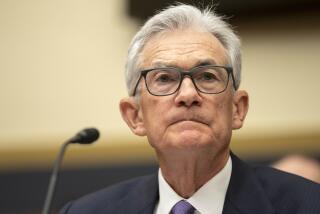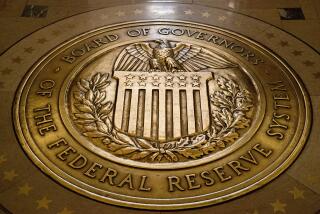Fed to begin providing forecasts of key interest rate shifts
The Federal Reserve, taking an innovative step in its public statements, will start providing a quarterly forecast of when it plans to make a shift in the key short-term interest rate that it sets — its latest effort to spur the sluggish economy and calm volatile stock markets.
The projections, to start late this month, could act as an economic stimulus by offering a tentative financial road map to consumers and businesses to encourage them to borrow and take risks. It also could help ease market tension and push down already historically low yields on long-term bonds.
The greater transparency should “encourage more risk taking if speculators know where the cost of funds would be for a longer time,” said Jack Ablin, chief investment officer of Harris Private Bank in Chicago.
The central bank’s new communications strategy, revealed in meeting minutes released Tuesday, also marks the latest in Fed Chairman Ben S. Bernanke’s unusual efforts to make the typically secretive institution more transparent.
It wasn’t long ago that the Fed shared almost no information about its thinking or decision-making process, preferring instead to influence markets and the economy by maintaining the element of surprise with its sudden announcements.
But under Bernanke, the Fed has steadily moved toward giving the public more information, believing, as other central bankers around the world do, that better communication of its plans and goals would reduce volatility in the markets and help to achieve the ends sought by the Fed.
Bernanke and others on the Fed’s policy committee had made clear in recent months that they were contemplating changes in their communications strategy, which some critics said provided too much information to the public.
Under the new practice, the Fed, at the end of its Jan. 24-25 meeting, will publish projections for what it sees as the target short-term rate in the fourth quarter of this year and the “next few calendar years,” according to the minutes of the Fed’s early December meeting.
The Fed will update the forecast four times a year, along with the already established practice of issuing projections for economic growth, unemployment and inflation.
In addition, the new forecast will provide the Fed’s latest thinking on when it would likely begin to make its first increase in its benchmark short-term rate. The Fed has held the so-called federal funds rate — an overnight lending rate that broadly influences rates on loans for businesses and consumers — near zero since December 2008.
Last August, the Fed said it expected to keep this rate at its rock-bottom level until at least mid-2013. Many investors, however, don’t see the Fed raising rates until 2014.
As such, analysts don’t expect the new communications strategy to have a major effect on the markets or the economy. A Fed forecast predicting a rate increase in 2014, for example, wouldn’t add anything to what many already are anticipating.
Moreover, the Fed’s pledge to hold the rate near zero through mid-2013, as well as its coming rate forecasts, isn’t a commitment to keep the rate there regardless of what happens. Rather, it’s conditioned on how the economy performs.
Still, the rate forecast could “increase the potency” of the Fed’s policies by helping to shape the behavior of companies, investors and consumers, said Alan Levenson, chief economist at mutual fund giant T. Rowe Price in Baltimore.
“If you tell your child that if you do X, I’m going to do Y, and they understand exactly what you mean by X and Y, you’re more likely to get the behavior you want,” he said.
Lyle Gramley remembers how in his days as a Fed governor from 1980 to 1985, the communications strategy was to keep things under wraps and try to surprise markets. “That’s no longer accepted doctrine in monetary policy,” Gramley said.
He noted that he didn’t see any downside to the change in strategy. But not everyone would agree. In fact, some of Bernanke’s colleagues on the policy committee “did not see providing policy projections as a useful step at this time,” according to the minutes.
Some committee members expressed concern that publishing their individual projections on the target rate “could confuse the public,” with some in the public viewing the forecast as a kind of promise to follow through on it.
“With [former Fed Chairman Alan] Greenspan, we didn’t get enough information,” Ablin said. “Under Bernanke, it seems we’re getting too much.”







